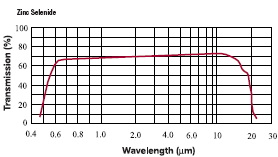Zinc Sulphide Multispectral (ZnS)
ZnS Multispectral (water-clear) is used for IR windows and lenses in the thermal band (8 to 14 µm) where maximum transmission and lowest absorption is required. Also selected for use where visible alignment is an advantage.
Transmission Range : 0.37 to 13.5 µm
Refractive
Index : 2.20084 at 10 µm
Reflection Loss : 24.7% at 10 µm (2 surfaces)
Absorption Coefficient : 0.0006 cm-1 at 3.8 µm
Reststrahlen Peak : 30.5 µm
dn/dT : +38.7 x 10-6 /°C at 3.39 µm
Density : 4.09 g/cc
Melting Point : 1827°C
Thermal Conductivity : 27.2 W m-1 K-1 at 298K
Thermal Expansion : 6.5 x 10-6 /°C at 273K
Hardness : Knoop 160 with 50g indenter
Specific Heat Capacity : 515 J Kg-1 K-1
Dielectric Constant : 88
Youngs Modulus (E) : 74.5 GPa
Apparent Elastic Limit : 68.9 MPa (10,000 psi)
Poisson Ratio : 0.28
Solubility : 65 x 10-6 g/100g water
Molecular Weight : 97.43
Class/Structure : HIP polycrystalline cubic, ZnS, F42m
Due to its good transmission in the VIS and IR, Cleartran is an ideal
choice for systems with a visible cameras,and and various IR detectors
or IR cameras.
Typeical application: Visible imaging, thermal imaging, FLIR, astronomy
Products manufactured: Lenses,aspheric lenses ,binary(diffractive) lenses,windows,beamsplitters and optical filters and prisms
Surface Finish: Typical 40-20 or 60-40 scratch-dig. Diamond Turned 100
Angstroms rms or better.
Surface Flatness: Range from 1/2 wave to 2 waves @633nm depending on the
system performance requirements.
AR coating: BBAR for 0.8 to 2.5µm, 3 to 5µm, 1 to 5µm,
8 to 12µm, and the 3 to 12µm spectral regions. Other specialized
bands are possible from 0.4 to 12 µm.
Product Notes:
Zinc Sulphide oxidizes significantly at 300°C, exhibits plastic deformation
at about 500°C and dissociates about 700°C. For safety, Zinc Sulphide
windows should not be used above 250°C in normal atmosphere.
Zinc Selenide (ZnSe)
ZnSe is used widely for IR components, windows and lenses, and for spectroscopic
ATR prisms. Zinc Selenide is one of the materials of choice for CO2 laser
optics operating at 10.6 microns.
Transmission Range : 0.6 to 21.0 µm
 Refractive
Index : 2.4028 at 10.6 µm
Refractive
Index : 2.4028 at 10.6 µm
Reflection Loss : 29.1% at 10.6 µm (2 surfaces)
Absorption Coefficient : 0.0005 cm-1 at 10.6 µm
Reststrahlen Peak : 45.7 µm
dn/dT : +61 x 10-6/°C at 10.6 µm at 298K
dn/dµ = 0 : 5.5 µm
Density : 5.27 g/cc
Melting Point : 1525°C (see notes below)
Thermal Conductivity : 18 W m-1 K-1 at 298K
Thermal Expansion : 7.1 x 10-6 /°C at 273K
Hardness : Knoop 120 with 50g indenter
Specific Heat Capacity : 339 J Kg-1 K-1
Youngs Modulus (E) : 67.2 GPa
Bulk Modulus (K) : 40 GPa
Apparent Elastic Limit : 55.1 MPa (8000 psi)
Poisson Ratio : 0.28
Solubility : 0.001g/100g water
Molecular Weight : 144.33
Class/Structure : HIP polycrystalline cubic, ZnS, F43m
Typeical application: Thermal imaging, FLIR.
Products manufactured: Lenses, Aspheric Lenses, Binary (diffractive) Lenses, Windows, Optical Beamsplitters and Optical Filters, Prism.
Surface Finish: Typical 40-20 or 60-40 scratch-dig. Diamond Turned 150
Angstroms rms or better.
SurfaceFlatness: Range from 1/2 wave to 2 waves @633nm depending on the
system performance requirements.
AR coating: BBAR for 0.8 to 2.5µm, 3 to 5µm, 1 to 5µm,
8 to 12µm, and the 3 to 12µm spectral regions and single wavelength
coating AR at 10.6µm. Many other specialized wavelength bands are
possible within the 0.6 to 16µm range.
Product Notes:
Zinc Selenide is produced by synthesis from Zinc vapour and H2Se gas,
forming as sheets on Graphite susceptors. Zinc Selenide is microcrystalline
in structure, the grain size being controlled to produce maximum strength.
Single crystal ZnSe is available, but is not common but has been reported
as having lower absorption and thus more effective for CO2 optics.
Zinc Selenide oxidizes significantly at 300°C, exhibits plastic deformation at about 500°C and dissociates about 700°C. For safety, Zinc Selenide windows should not be used above 250°C in normal atmosphere.
More II-VI compounds Crystal
II-VI compounds are generally compounds formed by elements from II & VI groups of
the Periodic table. Here we mean only binary (ZnSe, ZnS, ZnTe (also
for terahertz applications), CdSe, CdS, CdTe) and ternary (e. g., CdZnTe
or CdSSe) zinc and cadmium chalcogenides that are wide-gap semiconductors.
Semiconductor single crystals of CdxZn1-xTe (CdZnTe,
CZT, Cadmium Zinc Telluride) are important materials for the development
of far-infrared, visible light, X-ray detectors, and gamma-ray detectors
as medical imaging devices. CdZnTe (CZT, Cadmium Zinc Telluride) radiation
detectors have the advantages of a large absorption coefficient, compact
size and room temperature operation. Currently used high purity Ge and
Si detectors in industry and medical imaging can only work efficiently
at the liquid-nitrogen temperature.
There are many examples of the use of CZT (CdZnTe, Cadmium
Zinc Telluride) detectors in medical imaging and diagnostics, ranging
from simple x-rays carried out in a dentist's office to cardiac angiography,
bone densitometry measurements, and the use of nuclear medicine to pinpoint
areas of activity within the brain to help characterize conditions such
as epilepsy. In addition, the medical imaging community is interested
in developing large area CdZnTe (CZT, Cadmium Zinc Telluride) detector
arrays.
Cadmium zinc telluride (CdZnTe) has become a key detector
technology for hard x-ray and gamma ray astronomy. Astronomers use CZT
(CdZnTe, Cadmium Zinc Telluride) arrays to study the origin of high-energy
gamma-ray bursts. One class of astronomy instruments will use large area
single focal plane array detectors in conjunction with a focusing optic.
CZT (CdZnTe, Cadmium Zinc Telluride) is also suited for high-resolution
measurements and isotope identification in the nuclear industry and for
x-ray radiography applications. The use of single crystal CZT (CdZnTe,
Cadmium Zinc Telluride) as the gamma ray detector material has allowed
the production of very compact prototype imaging systems. Further applications
for CZT (CdZnTe, Cadmium Zinc Telluride) gamma ray detectors include space
flight gamma burst instruments, high-energy x-ray astronomy, and international
nuclear inspection and safeguarding.


